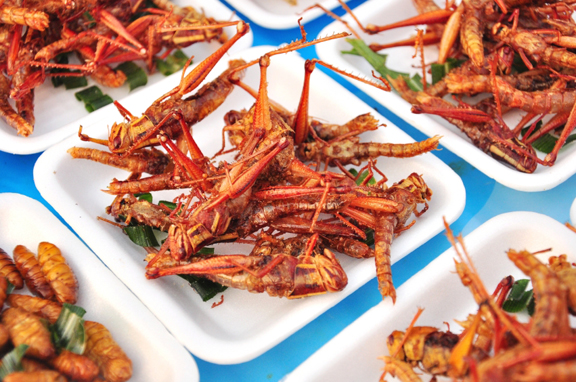We’ve all watched the scenes on survival television shows when the host chomps into the most disgusting bloated white grub for the sake of “survival.” Most of Western civilization cringes at the thought of it, while many in the East lick their lips in jealousy.
Eating insects for survival isn’t taboo for the majority of the world’s population. In fact, over 1,000 different insects are eaten by 80 percent of the world’s nations. This comes as no surprise if you’ve ever been to an Asian street market. Eating insects is so common that a word even exists to define it – entomophagy. With a scientific sounding name like that, it must be legit.
Like most reading this article, I have zero interest in eating grasshoppers for lunch today. However, as a survival instructor, it’s a topic that comes up rather frequently and one that warrants discussion.
All primitive cultures I’ve studied, including Native American Indians, ate insects. All primitive cultures still in existence still eat them as well. In survival, all edibles are fair game, and I wouldn’t hesitate for one second to eat creepy crawlies when starvation is the alternative. I had an uncle who ate insects while held capture in the Korean war. He ate other unspeakable things that kept him alive as well.
Insects may sound gross at this moment. That’s because you’re not starving. Perspective is the first to change when hunger sets in. Things you’d never consider as food start looking edible. In the case of insects, not only are they edible, many taste good and are incredibly nutritious.
Believe it or not, most insects are edible. There are, however, some major classes that are more popular than others. Beetles rank in at No. 1. Caterpillars, bees, ants, wasps, cicadas, grasshoppers, termites, locusts, crickets, larvae and grubs fall closely behind. Insects are rich in protein, minerals, vitamins, amino acids and fats. They are surprisingly comparable to beef and fish in the amounts of these nutrients.
I’ve personally eaten a variety of unknown beetle grubs (raw and cooked – the cooked ones taste like bacon fat), crickets, larvae, earthworms (which taste like chicken skin cooked), bees and bee larvae, ants and snails. I’ve found all of them to be surprisingly good. It really is a mental challenge more than anything.
Regardless of what’s shown on television, there are some basic guidelines that should be observed when dining on insects in the wild.
Guideline No. 1: Avoid brightly colored insects. Typically, bright colors are warning signs in nature. This is no exception when it comes to insects. A brightly colored insect is nature’s way of saying back off. Choose insects with natural earth tones if given the choice.
Guideline No. 2: Avoid hairy insects. Hairy insects can irritate the mouth and throat. Oftentimes, hairs can also be disguised as stingers. It’s best to avoid insects that appear to be fuzzy or hairy.
Guideline No. 3: Avoid smelly and pungent insects. Scent is another natural warning. If the insect stinks or sprays some kind of stinking liquid, then avoid it all together.
Guideline No. 4: Cook all insects. Though some insects can be consumed raw, it’s always best to cook them (and any other wild game). Many insects contain parasites, and cooking can put your mind at ease. Cooking also softens hard shells and helps to eliminate the “ick” factor of squishy guts.
Guideline No. 5: Avoid insects that feed on poisonous plants. Snails and slugs are notorious for dining on poisonous mushroom and fungi. While they themselves are edible, the stuff in their system might not be and could end up causing you problems. The solution is to starve them for a day or so or purge them on other edible plants. Don’t take any chances. The calorie reward isn’t worth the risk.
Humans can survive for over three weeks without food. In fact, it is our least important survival priority. Shelter, water and fire are all more important. Survivors are opportunists and should never turn down an easy snack, even if it’s a cricket. Gathering food in a survival scenario is oftentimes a collection of many different sources, and the occasional insect could very well be a part of that mix.
Remember, it’s not IF, but WHEN.














4 Comments